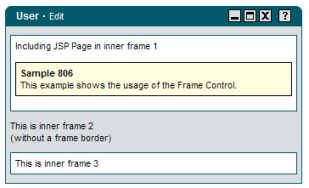| Attribute | Type | Description | Req. | RTExp | ||||||||||||
| action | String |
Specifies the Struts Action that is to be called in case of control element events.
This attribute need not be specified if the tag is included within a Struts <html:form> tag. In that case, the name of the action is determined using the Struts Form Bean. Annotation: The action must be declared in one of the struts-config.xml files. |
 |
|||||||||||||
| caption | String |
The main title of the form.
The title and detail can also be specified together in the form "title - detail. |
 |
|||||||||||||
| detail | String | The detail title of the form. |
 |
|||||||||||||
| help | String |
Allows to assign a help id for the element. If set, a help symbol
will be displayed beside the element, which will generate an onHelp
event if the icon is clicked. The id can be used to display a special page
of the help system. The help system is not part of the Common-Controls
Framework.
To generate the hyperlink some default framework resources where used:
Annotation: A jump screen of the Help system must be specified. |
 |
|||||||||||||
| hideButtons | String list |
This attribute can be used to hide some of the buttons.
The buttons needs to be specified within a semicolon separated list.
Annotation: A semicolon separated list. The button names must match values of ControlButton.getName() |
 |
|||||||||||||
| id | String |
The name of a page scope JSP bean that will contain
the current element.
Using the given Id, the variable can be
accessed in scripting expressions in the tag Body.
The id mus be a string lteral because the JSP
compiler generates a variable withthis name at compile
time
Annotation: A valid Java identifier must be given. |
 |
|||||||||||||
| locale | String |
enables localization for the control element.
String literals will be interpreted as keys
in the Application.properties file.
Annotation:
boolean value |
 |
|||||||||||||
| name | String |
Specifies the name of the Java-Bean.
The Java-Bean must be stored in the given scope.
When the tag is surrounded by a Struts <html:form> tag, no Bean Name need be specified. In this case, the Java-Bean is drawn via a property of the Struts Form Bean. Annotation: A valid Java identifier must be given. |
 |
|||||||||||||
| noframe | Boolean | Can be used to hide the border for the control. The buttons will still be displayed above the control (depends on the registered PainterFactory. |
 |
|||||||||||||
| permission | ACL |
With this attribute, access to the element can be restricted.
Authorizations are checked using the com.cc.framework.security.Principal object in the user session. The principal object is registered in the session with the method com.cc.framework.security.SecurityUtil#registerPrincipal(HttpSession, Principal). It is made available by the application developer by implementing the principal interface. In this manner, any authorization system can be very easily connected within the framework. Authorizations are always specified in the form of an Access Control List (ACL). What is involved here is a semicolon-delimited list with individual authorizations. The framweork supports the following authorization types, which, however, can be expanded at will by the application developer:
|
 |
|||||||||||||
| property | String |
Specifies the name of the property using which the Java-Bean
is to be accessed. This is generally only necessary when
the Java-Bean is associated with a Struts Form Bean.
Annotation: A valid Java identifier must be given. |
 |
|||||||||||||
| scope | HTTPScope |
This attribute shows the Scope in which the Java-Bean with
the actual display data can be found.
|
 |
|||||||||||||
| style | String |
An HTML-style can be directly specified with this attribute.
Annotation: See HTML documentation for the attribute style. |
 |
|||||||||||||
| styleClass | String |
The HTML-class attribute of the element can be specified with this attribute.
Annotation: See HTML documentation for the attribute class. |
 |
|||||||||||||
| summary | String | This property can be used for rendering to non-visual media such as speech or Braille. |
 |
|||||||||||||
| transaction | Boolean | This flag directs the framework to append a transaction token to all generated hyperlinks. The transactio token allows the detection of form re-submissions (multiple submission of the same HTTP form). |
 |
|||||||||||||
| width | String |
Specifies the width of the form window. The height may be
specified in absolute or percent terms.
See HTML-Documentation |
 |
